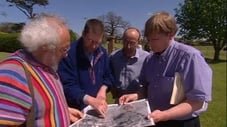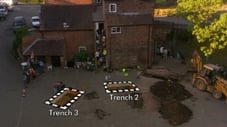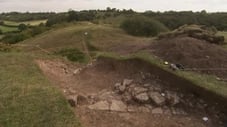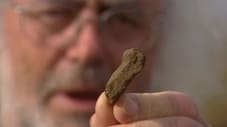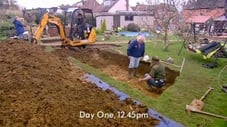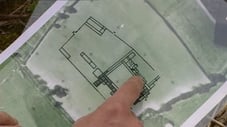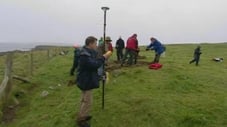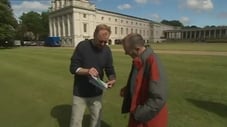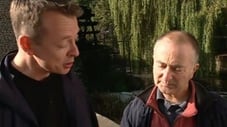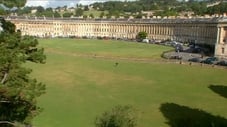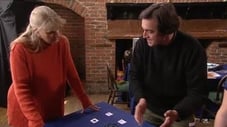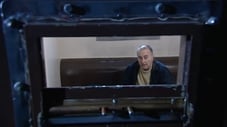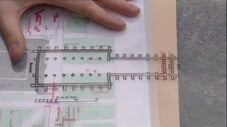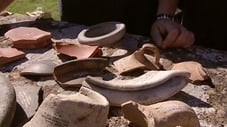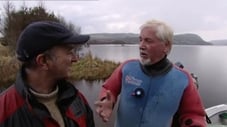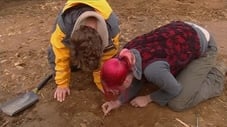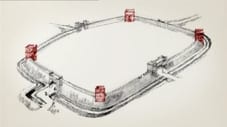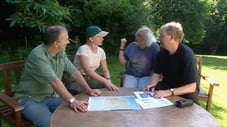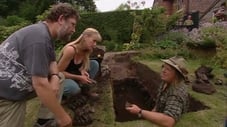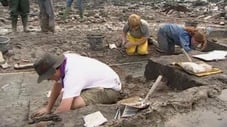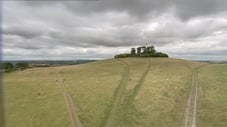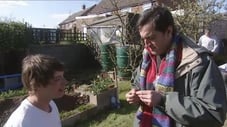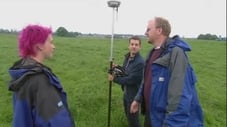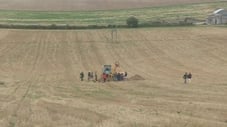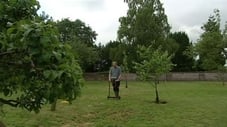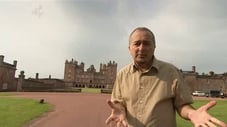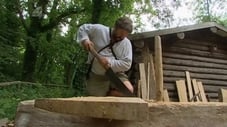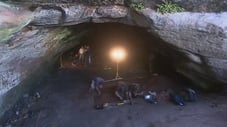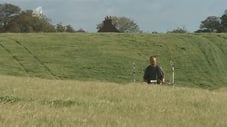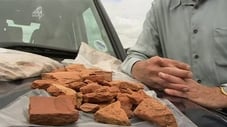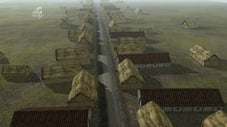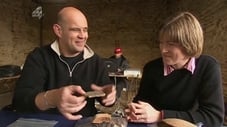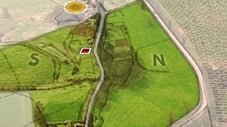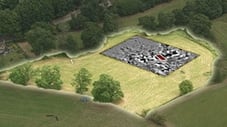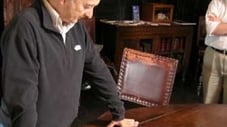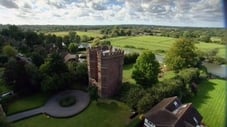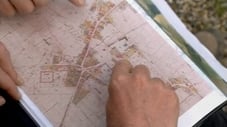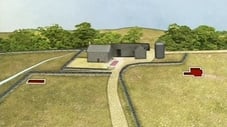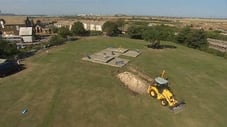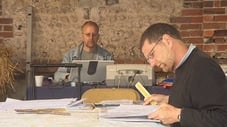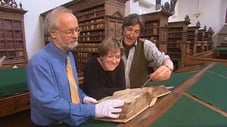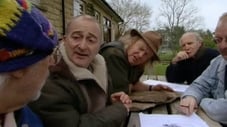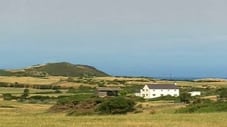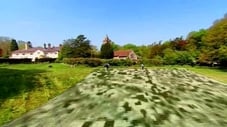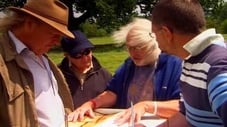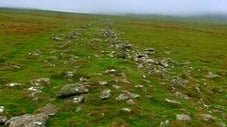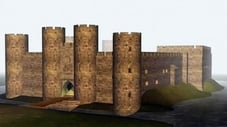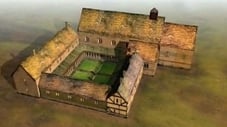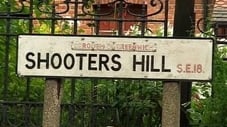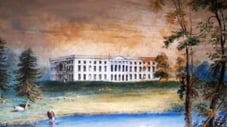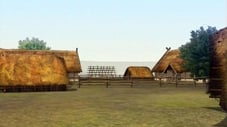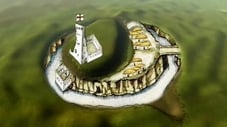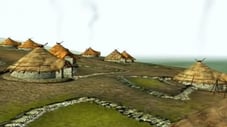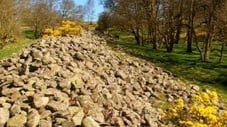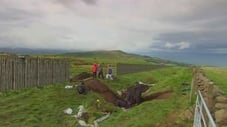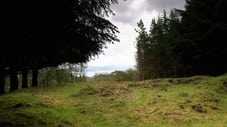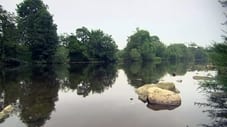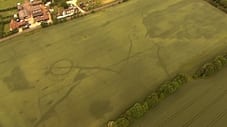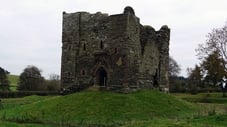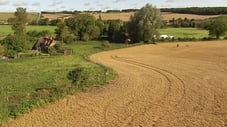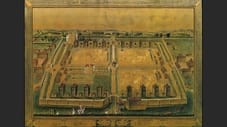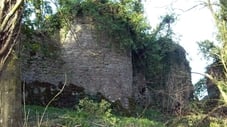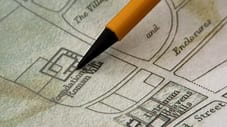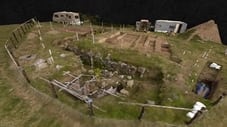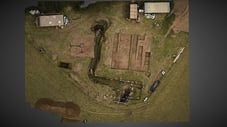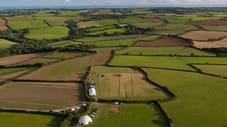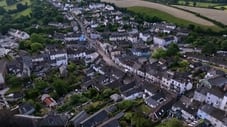
Time Team (1994)
← Back to main
Henry Chapman as Self - Surveyor
Episodes 119
London's First Bridge - Vauxhall, London
At low tide on the foreshore of the Thames near Vauxhall Bridge in central London, a series of timber stumps is visible. How old are they, and what was their purpose? Time Team have the task of finding out, before the stumps are destroyed forever. They want to create a picture of the Bronze Age landscape here, 3,500 years ago. Post holes would indicate dry land building, while piles (pointed stakes driven into the ground) would indicate a structure above the river. To find out, they have to dig up one of the massive stumps. It's a race against time and tide to get it done in three days. Phil helps Damian Goodburn to make a simple piledriving rig with authentic tools. Stewart and Mick take a trip on the London Eye, to help them map the course of the ancient river. They are joined by Gustav Milne from University College London, and Jon Cotton from the Museum of London.
Read MoreThe Roman's Panic - Ancaster, Lincolnshire
Ancaster has yielded numerous Roman finds as well as a large cemetery with several sarcophagi from the period. In addition, the church is known in British archaeology for a Roman inscription dedicated to the deity Viridius. Phil finds the cemetery level, while Carenza discovers a layer filled with jumbled up human remains mixed with other bones. In the cemetery, Phil eventually uncovers the lid of a possible sarcophagus, and its excavation could thus require certain precautions due to the potential for lead poisoning and presence of biological hazards. However, the object proves to be a cist burial, as well as hazard-free. Incredibly, one of the cist slabs also turns out to contain yet another inscription to the god Viridius. In the end, the archaeologists suggest that the massive defences were ordered to be put up by the Roman central administration in Britain, and completely disrupted the original town layout.
Read MoreDiving for the Armada - Kinlochbervie, Sutherland
The team travel to West Scotland to investigate the wreck of a ship that may have been part of the Spanish armada. As this is a classic case of rescue archaeology, they are joined by the government's Archaeological Diving Unit, whose director Martin Dean explains why this exercise is so important. An ROV is operated from the surface. Historian Felipe Fernández-Armesto talks about the role played by the weather in the Spanish armada. Pottery specialist Duncan Brown looks at several remarkable finds, including some Maiolica ware. Both Phil and Tony do some diving. With the help of marine archaeologist Mark Lawrence, John uses a magnetometer to survey the seabed.
Read MoreThe Naughty Monastery - Chicksands, Bedfordshire
The team are invited to investigate the officers' mess of a military base in Bedfordshire, once home to monks and nuns of a 14th century Gilbertine Order. It was an experiment in unisex living. Jenni of Time Team volunteers to live like a nun during the dig, and is initiated by nunnery expert Roberta Gilchrist. John Ette from English Heritage monitors proceedings, and they are also joined by historian Richard K. Morris and osteoarchaeologist Margaret Cox. Robin Bush tells the miraculous tale of the Nun of Watton.
Read MoreThe Furnace in the Cellar - Ironbridge Gorge, Shropshire
The team head for a pub in Leighton, whose cellar contains the remains of a blast furnace once used for smelting iron. When Tony arrives, test pits are already being dug, and Geophysics are busy surveying the car park. They are joined by Paul Belford from Ironbrige Gorge Museum; and Jonathan Roberts shows Phil how to make a triangular charcoal clamp similar to those used in the 17th century. Mick visits the nearby Blists Hill Victorian Town, where Roger Fewtrell demonstrates making a 24 pound cannonball. They are also joined by researcher Colin Thom, industrial archaeologist Rob Kinchin-Smith, archaeometallurgist Gerry McDonnell, and finds expert Ceinwen Paynton.
Read MoreAn Ermine Street Pub - Cheshunt, Hertfordshire
It is 40 years since amateur archaeologists dug up Roman remains near Ermine Street, now hidden beneath Cheshunt Park. Time Team tell the story of the original excavation, using the detailed plan to conduct their own investigation. They believe the site's proximity to the road is the key to this dig. With some brilliant work by Stewart and John, they soon locate part of the road. Though frustratingly they cannot find any trace of it beneath the surface, they do find a brewery and possibly a pub. The brewing process is described by ancient technology expert Peter J. Reynolds. They conduct a mini-experiment comparing Roman surveying techniques with Henry's modern equipment. They are also joined by Roman experts Rosalind Niblett and Harvey Sheldon.
Read MoreIron-Age Market - Helford, Cornwall
Two massive hill forts on the Lizard Peninsula in Cornwall, at Gear and Caer Vallack, have never been excavated. In fact, no major Cornish Iron Age site has ever been investigated. Time Team have been given the tall order of making some sense of these two sites in three days. For many years, a local farmer has been collecting Stone Age and Iron Age artefacts. Already the geophysics results are showing a potential wealth of ancient human activity. But the sites are so huge that the team will have to be very selective. They are joined by Ian Morrison from English Heritage, ancient technology expert Peter J. Reynolds, pottery experts Carl Thorpe and Henrietta Quinnell. Re-enactor David Freeman demonstrates a sling-shot, a simple but effective weapon. Phil and Peter visit a reconstructed round house nearby.
Read MoreSiege House in Shropshire - High Ercall, Shropshire
The owners of a Tudor house, High Ercall Hall, want Time Team to investigate a bloody confrontation between the Roundheads and Cavaliers during the English Civil War, 350 years ago. In front of the house are four mysterious arches. Could they be relics of an older, medieval building, which apparently stood here for centuries before the present building? They are joined by buildings expert Richard K. Morriss, and Civil War specialist Glenn Foard.
Read MoreA Prehistoric Airfield - Throckmorton, Worcestershire
Hoping to uncover Bronze Age burials, the team descend on a disused airfield. But initial finds suggest the Iron Age, while geophysics shows plenty of circles and some larger rectangular enclosures. Jacqui Wood makes prehistoric cheese, and cooks a fish stew. Bronze Age enthusiast Francis Pryor gets excited about some faint track marks. They are joined by Malcolm Atkin and Robin Jackson from Worcestershire County Council, Ian George from English Heritage, and Iron Age expert Jeremy Taylor.
Read MoreA Lost Roman City - Castleford, Yorkshire
The medieval castle of Beaudesert in Henley-in-Arden suddenly vanished without trace, leaving a single stone on top of a mound. The people want to know what it looked like. "The Mount" as it's called by the locals, is a popular beauty spot and has suffered from erosion. Also, as it's a scheduled monument, there are limits to what digging can take place. The castle was built by the de Montforts in the early 12th century. Henry and Stewart create a simple 3D clay model of the building, which follows the natural contours of the hill. It looks as if the castle was demolished and the pieces sold off in the 15th century. Using authentic tools, bowyer Steve Ralphs makes a medieval longbow, which is tested against a crossbow of a similar period. Castles expert Sarah Speight describes daily life in the castle. Finds include a section of carved pestle and mortar.
Read MoreEvery Castle Needs a Lord - Beaudesert, Warwickshire
The medieval castle of Beaudesert in Henley-in-Arden suddenly vanished without trace, leaving a single stone on top of a mound. The people want to know what it looked like. "The Mount" as it's called by the locals, is a popular beauty spot and has suffered from erosion. Also, as it's a scheduled monument, there are limits to what digging can take place. The castle was built by the de Montforts in the early 12th century. Henry and Stewart create a simple 3D clay model of the building, which follows the natural contours of the hill. It looks as if the castle was demolished and the pieces sold off in the 15th century. Using authentic tools, bowyer Steve Ralphs makes a medieval longbow, which is tested against a crossbow of a similar period. Castles expert Sarah Speight describes daily life in the castle. Finds include a section of carved pestle and mortar.
Read MoreSteptoe Et Filius - Yaverland, Isle of Wight
Two years ago, local archaeologist Kevin Trott discovered Roman remains in a trench being dug for a water pipe. Unfortunately the trench had to be closed, and now Time Team are having trouble finding it. While Phil and the diggers look for the original trench, a full-scale field-walking exercise reveals many finds, both Roman and Iron Age; including a lot of bronze jewellery, seeming to show industrial activity. There are hints that enamelling was carried out here, so they decide to make their own enamelled hare brooch. Mick and Tony visit a nearby Roman villa with a detailed mosaic floor. On day three, Stewart spots some potential earthworks in a neighbouring field; so they decide to dig some exploratory trenches there. They end up with examples of activity from the Bronze Age, Iron Age, Roman occupation, and Anglo-Saxon period. To cap it all, at the end of day three they find a rare Iron Age burial. The team are joined for the first of many digs by Anglo-Saxon expert Helen Geake.
Read MoreSeven Buckets and a Buckle - Breamore, Hampshire
A Byzantine brass bucket was found during a 3-day live dig in a Saxon cemetery a year ago. Time Team returns to find out more about the people who lived and died here. Metal detectorists are called in to find non-ferrous metals, to complement Geophysics' magnetometer survey. They are joined by Anglo-Saxon specialist Andrew Reynolds, paleopathologist Alice Roberts and celebrity Sandi Toksvig. Sandi's ancestors were from Jutland, and Robin Bush argues that this whole area of Hampshire was actually occupied by Jutes before they were defeated by the Saxons under King Cadwalla in 686 AD. Ray Walton replicates a brass bucket, complete with inscriptions and silvering, from scratch. Osteoarchaeologist Margaret Cox tries to make sense of the burials including rare double burials – one of which uniquely has a child placed between two men. Finds include weapons and an exquisite enamelled belt buckle; and three more of the mysterious buckets, which all fit one inside the other.
Read MoreGarden Secrets - Raunds, Northamptonshire
Time Team investigates a back garden in Raunds, where a skeleton – aptly named Henry by his discoverer – has been found along with his Anglo-Saxon grave goods. The burial probably fits in with a number of other Saxon sites in the town and is seen in light of these. The team also look carefully at Henry himself, his attributes, anatomy and ailments, and have to tackle several logistical problems in association with excavating in such a constrained area as a garden. However, they also find the opportunity to extend the investigation across the fence to an allotment area behind the gardens. The experimental part of the program looks at various objects and medical remedies found in Anglo-Saxon society, presented by historical reenactors, while Victor recreates the appearance of Henry. In the end the archaeologists do confirm the presence of an Anglo-Saxon cemetery with various pieces of grave goods at the site, probably placed in relation to older Bronze Age burial mounds.
Read MoreMosaics, Mosaics, Mosaics - Dinnington, Somerset
Time Team travels to Somerset to investigate the discovery of an exquisite Roman mosaic in a field. The geophysical survey clearly indicates the presence of a substantial and well-preserved villa on the site. One of the main problems they tackle is the development of the building complex through time. By targeted examination of the structural remains, the archaeologists uncover evidence of several phases from a more humble early timber building to a two-story grand villa with two large ranges and a courtyard gate structure. In the end, the site turns out to contain one of the largest Roman villas in the UK.
Read MorePeak District Practices - Carsington, Derbyshire
Time Team examines a mysterious cave in Derbyshire where cavers have found several skeletons, some of them newborn babies and the earliest dated to the Stone Age. Finds from the cave have also provided dates from the Iron Age and the Roman period. The excavation proves potentially quite hazardous, as the chambers and tunnels are filled with precariously heaped stones which threaten to scree if the safety shoring moves or breaks, and some areas are considered just too unstable to work in at all. The archaeologists also investigate a nearby Bronze Age barrow, which previously has been subject to illicit excavation. In the cave they find more human and animal remains, although how these got there remains subject to some debate. The mound gets confirmed as a barrow and undisturbed secondary burials are discovered as part of the structure.
Read MoreThe Giant's Grave - Fetlar, Shetland
Time Team investigates a Shetland back garden for remains of Viking occupation after the discovery of a number of soapstone objects there. They also open a mound feature nearby called The Giant's Grave to see whether or not in fact it may be a Scandinavian boat burial. In the garden they find more soapstone objects, slabs with crossmarks, small souterrains, and wall lines, indicating the presence of a Viking Age farmstead. Phil tries to carve a soapstone lamp as the experimental part of the program. The mound turns indeed out to be a looted Scandinavian boat burial, as the team finds patterns of iron rivets showing the imprint of the vessel and a small piece of its keel – and by excavating carefully, the archaeologists also locate a Viking tortoise brooch not taken by the looters.
Read MoreJoust Dig It - Greenwich, London
Time Team investigates Placentia, the Greenwich palace of king Henry VIII. They try to locate his royal armoury and the tiltyard, where the court and nobility would have jousted and been entertained in mock castles. In the experimental part of the program, Tony looks at how Tudor armour would have been made and gets a breastplate of the period hammered and fitted. The armoury as a turns out to be too elusive for the archaeologists, but localized amounts of hammer scale, a residual product of forging, indicate its presence there. However, the tiltyard complex with its associated structures, like the banqueting hall, are firmly located.
Read MoreDigging Liberty - Merton, London
Tony Robinson and the team are hunting for Liberty's first factory in South London. 'Liberty silks' still evoke images of opulence and beauty, of floating dresses and more leisurely times. But their hunt proves far from leisurely.
Day three of the search brings the vital breakthrough – as well as an extraordinary attempt to recreate the 19th-century techniques of dying and printing those wonderful silks.
Read MoreDeath in a Crescent - Bath, Somerset
Time Team visit Bath to investigate parch marks seen in the park lawn of the Royal Crescent, indicating the presence of a large Roman road, possibly local remains of the Fosse Way. They also look behind the Crescent for Roman sarcophagi and wall lines found by builders of the now-gone St. Andrew's Church in the 1870s and noted by an antiquarian at the time. While the road ditches eventually yield Roman burials, the team does not locate any sarcophagi said to have been found there. Whether or not the large road, in fact, is the Fosse Way remains in the end uncertain, with arguments for both sides.
Read MoreBack to Our Roots - Athelney, Somerset
Time Team revisits Athelney Abbey, the hideaway of Alfred the Great, and also the very first site investigated by the team one hundred programs earlier. Ten years of technological advances in the meantime has significantly enhanced their geophysical survey methods and changes in heritage management attitudes have also given them the permission to dig at the site. Slag and magnetic readings suggest that iron and steel was smelted and worked at Athelney, the latter being a good indication of Anglo-Saxon presence. At the abbey site itself Phil and his diggers uncover several burials. Reenactors show Anglo-Saxon dress and weaponry and their Viking counterparts as the experimental part of the program, while Carenza and Tony make – and burn – traditional Saxon cakes. The archaeologists find a number of objects, a Medieval graveyard associated with Athelney abbey, a metalworking complex, and a substantial defensive ditch dug in the Iron Age, but reused in the time of king Alfred.
Read MoreLooking for the White House - Kew Gardens, London
Time Team visits Kew Gardens to find the White House, part of the second Kew Palace complex and favourite home of mad king George III. While Carenza is shown how decorated wine glasses of the period are made, Stewart induced a lot of confusion regarding the exact placement of the building due to inaccuracies in the original 18th-century map of the area. However, in the end, both the archaeology and the architectural plan match each other. The archaeologists also locate a tunnel for sheltered transport of meals from the kitchen block to the palace dining halls by combining geophysical survey with keyhole test pits.
Read MoreRescuing the Dead - Leven, Fife
A building development threatens a Bronze Age cemetery in Fife, and Time Team is there to carry out rescue excavations together with County Archaeologists. The graves are Cist burials in various states of preservation placed around a large boulder in a dug pit. The boulder is shown to cover another cist, and several of the burials contain in fact bones – not a certainty, given the acidity of the local soil – and grave goods. With skulls initially being found as the only form of human remains, the archaeologists wonder whether the site only contained skulls originally. The boulder cist is capped by a large stone slab covering a void beneath, and the logistics of lifting it prove a challenge. In the end, they uncover a chamber with skeletal remains, thus showing soil acidity to be the main culprit for the dearth of bones other than skulls in the other graves.
Read MoreNot a Blot on the Landscape - Castle Howard, Yorkshire
Time Team travels to Castle Howard to look for the lost village of Henderskelf, which was demolished around 1700 to make way for the new castle constructed on the estate and its formal gardens. But the exact placement of the village is uncertain. The geophysical survey is unable to help much so the team relies on a map from 1694 and visible lumps and bumps. Geophysics produces better results in their search for the lost village church of Henderskelf. Stewart advances their investigation significantly when he discovers a more detailed sketch of the village on the back of another old map from c. 1700 in the Castle Howard archives, but it scales poorly onto a modern map. When this is done, the team realizes that some of their trenches have missed target buildings altogether. Armed with all this evidence, the archaeologists finally get to grips with the elusive Henderskelf – which seems to have been utterly removed between 1700 and 1720 when the new castle was erected.
Read MoreA View to a Kiln - Sedgefield, County Durham
Roman finds from Sedgefield prompt Time Team to visit a field and subject it to investigation. Air photographs and geophysical survey show tantalizing signs of activity below the turf, while fieldwalking provides even more finds. However, these finds lead to some confusion, as the archaeology suggests a low-status site with farms or workshops, but the coin finds are of high quality and value. The coins are decided to originally have formed a hoard, presenting certain bureaucratic issues for the metal detectorists who brought Time Team to the site. The experimental part of the program investigates how Roman coins would have been mass produced. In the end, the archaeologists discover a well-preserved pottery kiln in a settlement complex they suspect represent a civilian industrial site supplying the Roman market in Britain – all of which Phil gets to show the local MP, Tony Blair.
Read MoreJailhouse Rocks - Appleby-in-Westmorland, Cumbria
The police in Appleby-in-Westmorland, Cumbria, know that their station dates back to the first gaol built on the site in the 1770s. They also know that two subsequent prisons, from the 1820s and the 1870s, also stood on the site. They invite Time Team to see what remains of the former prisons underneath their car park. Trench 1 finds the remains of the room where the 1870s prison's treadwheel was, trench 2 finds the remains of the 1770s cell block, which has its own story to tell. Trench 3 discovers the women's prison of the 1820s (previously prisoners were not segregated by sex), which had an underfloor heating system. One archaeologist volunteers to become a Victorian-era prisoner for 24 hours, put to hard labour breaking rocks, turning a crank handle to no purpose, and moving dirt from one pile to another. Finds include part of a warder's uniform and hobnail boots, and a bar from a prison window. Carenza acts as historian for this episode.
Read MoreIn Search of the Brigittine Abbey - Syon House, London
The team are on the trail of a medieval mystery. Founded by Henry V and built by his son Henry VI, Syon Abbey was a large, wealthy monastery for nuns of an obscure Swedish order. During the reign of Henry VIII it vanished. Its remains lie beneath the lawns of modern Syon House, designed by Capability Brown. What they find is on a huge scale. But there is disagreement as to what kind of building it was. After investigating the foundations of the House, Stewart and Jonathan reach an agreement on the extent of the church. They are joined by buildings historian Jonathan Foyle and monastic expert Barney Sloane.
Read MoreA Roman Bath House and Edwardian Folly - Whitestaunton Manor, Somerset
Next to the beautifully manicured lawns of Whitestaunton Manor in the Blackdown Hills of Somerset lies a patch of muddy weeds. Coins and pottery have been found here, and it is supposedly the site of a Roman villa. But archaeology student Freya Bowles thinks differently. The team first have to remove weeds and tree roots without the use of mechanical diggers, as it's a scheduled monument. They are also extremely limited as to the size of the excavation. Clearly there are Roman remains, but mixed up with Victorian or Edwardian garden features. Gradually the plan of a Roman bath house emerges. The team are joined by mosaic specialist David Neal and buildings historian Jonathan Foyle. Directed by technological historian Robert Spain, they build a full-size replica hypocaust complete with under-floor heating.
Read MoreThe Crannog in the Loch - Loch Migdale, Scottish Highlands
There's an island-ish round area of stones in Loch Migdale - could it be a crannog? 200 meters away on the banks is a small (12 m diameter) circular feature - is it a henge? Time Team rounds up some experts on the prehistoric and finds out. They set up a suction dredge to investigate two areas of the loch feature, and find wonderfully preserved timber, proving that it's a built structure and thus a crannog. GPS surveying and a tip from a local farmer finds the causeway, now underwater, leading to it Trenches within the henge show that the entrance and wooden posts within it pointed towards notable features in the landscape. Stewart looks for the find site of the Migdale Hoard.
Read MoreSaxon Burials on the Ridge - South Carlton, Lincolnshire
The team investigate a possible fifth century cemetery in a ploughed field, where they find a metal shield boss. One male skeleton is holding a drinking vessel. There are hints of much earlier activity as well, including a Bronze Age barrow. Using authentic tools, they fashion a Saxon shield. Conservator Dana Goodburn-Brown examines the details in the x-rays of the shield boss; while Phil and members of Regia Anglorum demonstrate how the shields are used in battle. They are joined by bone specialists Alice Roberts and Margaret Cox, who unearth some coloured beads among the remains.
Read MoreThe Roman Fort That Wasn't There - Syndale, Kent
Nobody knows what happened immediately after the Romans arrived in 43 AD, because no Roman fort has been discovered in this part of South East England. Time Team are on a mission to find the missing link. Local archaeologist Paul Wilkinson believes he has already found a military ditch, which would surround such a fort. It's a prime site, right next to Watling Street. However geophysics cannot find any evidence for a ditch. So begins one of their most frustrating digs, directed by Neil Holbrook. Phil enlists in the Ermine Street Guard for a day. They are joined by Roman expert Tony Wilmott and pottery specialist Malcolm Lyne.
Read MoreAn Iron-Age Trading Centre - Green Island, Dorset
Green Island in Poole Harbour has already shown that it was a significant centre of Iron Age activity, with evidence of industrial activity and trading to and from the continental mainland. But it has never been properly excavated. Two huge jetties - now buried - indicate either a port or a defensive structure. The island is a SSSI (Site of Special Scientific Interest), which means hand-digging only, and replacing the topsoil. Very soon the finds start to multiply. Of particular interest is evidence of shale working for jewelry, and iron smithing. They are joined by Project Director Eileen Wilkes, archaeologist Miles Russell, Iron Age specialist John Collis, and metallurgist Roger Doonan. Experimental archaeologist Jake Keenan demonstrates shale working with primitive tools. Geomorphologist Vincent May explains that in prehistoric times the water level was two metres lower, and Green Island was much bigger.
Read MoreA Medieval Blast Furnace - The Old Furnace, Oakamoor, Staffordshire
The team are revisiting the garden of Furnace Cottage in Churnet Valley, where the previous excavation of an Elizabethan blast furnace produced evidence of much earlier iron-making. Stewart surveys the landscape, to piece together a picture of water flow and other features essential to iron smelting. But John is convinced that there is strong geophysical evidence for a furnace a mile away at Eastwall Farm. It could even be water-powered - a major discovery. They build a medieval style bloomery. They are joined by historian Pete Brown, and archaeologists David Cranstone, Bill Klemperer, Deb Ford, Gerry McDonnell, Tim Young.
Read MoreRescuing a Mesolithic Foreshore - Goldcliff, Newport
When the tide recedes at this point on the Severn estuary, rare evidence of stone age activity is uncovered. Time Team are on a three-day mission to help recover some of these relics before they are washed away. It involves excavating and painstakingly examining 15 cubic metres of muddy silt; but time is against them. The Mesolithic period is poorly understood, because these people were highly mobile hunter-gatherers who did not build permanent structures. They uncover some of the smallest artefacts they have ever handled. Phil and Brigid are fascinated by ancient footprints of adults and children, preserved in the sand. Phil excavates the massive tooth of an aurochs, an extinct giant prey animal. They are joined by Martin Bell of Reading University, Mesolithic specialists Nick Barton and Robin Crompton, and food expert Jacqui Wilson who cooks up a stone age feast.
Read MoreFertile Soils, Rich Archaeology - Wittenham Clumps, Oxfordshire
The British landscape is littered with Iron Age hill forts. A local archaeology unit is digging such a hill fort in Oxfordshire, but cannot afford to investigate a neighbouring larger hill, only 200 metres away. Both Roman and Iron Age remains have been found there in the past. But what is its relationship, if any, to the hill fort? The geophysics team identify a potential target, a square enclosure on the side of the hill. But before they can begin, they have to manually search the site for specimens of great crested newt, a rare protected species. At the beginning of day two, John's team find something which could be very special, a Roman church, apparently with a semicircular apse. They are joined by Tim Allen of Oxford Archaeology and osteoarchaeologist Angela Boyle.
Read MoreKing Cnut's Manor - Nassington, Northamptonshire
Digging up fields and car parks and back gardens is all very well, but how could Time Team pass up a chance to dig up a living room? The manor house in Nassington was purchased in a derelict state, and while restoring it, several massive post holes were investigated that are of a size and spacing to be a Saxon great hall. The pottery finds from the property suggest almost constant occupation from the Iron Age to the present, and the Ramsey Chronicle records that Cnut owned Nassington while king. Up comes the flooring so three trenches can be dug inside the house, while outside, various trenches are dug in the garden. It seems that hall after hall was built where the manor house still stands, but no trace can any longer be found of outbuildings which must have been there. Graeme Lawson visits with a selection of Dark Ages musical instruments, makes a reed pipe of elder wood, and plays out the episode with the Time Team theme music on pipe and lyre.
Read MoreBack-Garden Archaeology: Revisiting a Roman Villa - Ipswich, Suffolk
As renowned Suffolk archaeologist Basil Brown discovered, Castle Hill near Ipswich is named, not after a castle, but a substantial Roman villa. Brown was unable to complete his excavation, and Time Team have been called in by local schoolchildren to find out more. However, they will need to dig up a few back gardens to do so. Very soon it becomes clear that Brown's measurements were out of kilter. Halfway through day two, Phil makes a breakthrough. But not until 11 trenches are dug in 8 gardens does a full picture emerge. The team are joined by Roman specialist David Neale and site director Miles Russe
Read MoreThe Lost City of Roxburgh - Roxburgh, Scottish Borders
Tony and the team search for the remains of Roxburgh, one of medieval Scotland's four great centres, but which has vanished beneath the pasture surrounding the ruins of Roxburgh Castle.
Read MoreBrimming with Remains - Cranborne Chase, Dorset
Pigs rooting in a windswept field in Dorset unearthed fragments including Roman mosaic floor tiles. In addition, a Bournemouth University excavation team located some burials nearby. The farmer, Simon Meaden, has asked Time Team to investigate further. John's geophysics survey reveals a lot of activity. Very soon multiple finds start appearing, and to Tony's delight he is allowed to dig up a little beaker. Archaeologist Mike Parker Pearson produces a timeline of prehistoric and historic burial practices. Phil's trench is invaded by chickens. Gradually a complex picture emerges of human activity here over thousands of years, including a heated Roman villa with bath-house.
Read MoreThe Manor That's Back to Front - Chenies Manor House, Buckinghamshire
Tony Robinson and the team visit Chenies Manor which is believed to have been upgraded in time for Henry VIII's visit around 1530. However, while a late 16th-century inventory suggests that an additional range of rooms fit for a king once existed, traces of them have vanished since the house fell into disrepair. Can the experts uncover the layout of the building as it appeared in Tudor times?
Read MoreThe Monastery and the Mansion - Nether Poppleton, Yorkshire
The villagers of Nether Poppleton, near York, join Tony Robinson and the team for some extensive digging as they try to determine the exact age of their village. The current layout follows a typical medieval pattern but a reference to the village in the Domesday Book has the experts thinking that it could date back to Saxon times at least.
Read MoreThe Bombers in the Marsh - Warton near Preston, Lancashire
On 29 November 1944, two US Douglas A-26 Invader bombers crashed in Warton Marsh. Both planes, along with a number of others, had left Warton Airbase in formation, en route to join forces in the preparations for the Battle of the Bulge. Only one minute off the runway and 1,000 feet into the air, the aircraft collided and came to rest in the marsh. All the crew died. Their bodies were recovered from the planes, but an investigation into the causes of the crash was inconclusive.
For this programme, Time Team enlisted a veteran air crash investigator, along with the RAF's 'crash and smash' team and other experts to try to find out what caused the crash. Each of the planes, including the engines, was believed to be relatively intact and, it was hoped, would provide the necessary information to determine why these two planes collided.
Read MoreFighting On The Frontier - Drumlanrig, Dumfries and Galloway
Twenty years ago, during a particularly dry summer, parch marks revealed what seemed to be a huge Roman fort a few hundred metres from the Duke of Buccleuch's extraordinarily grand house, Drumlanrig Castle, in Dumfries. The discovery lay untouched until Time Team took on the challenge to investigate it further.
The Team sought to answer a number of questions. Was it actually a Roman fort? If so, it was one of the most northerly ever found and therefore of special importance to Scotland's history. So when were the Romans there? No finds made previously had given any hint of the date of the structure.
Time Team also wanted to identify the roads leading in and out of the fort. Was there any kind of civilian settlement or other features nearby? And could the Team work out how the Romans made their famous draco, the military standard that made a sound said to have struck fear into the hearts of their enemies?
Read MoreA Neolithic Cathedral? - Northborough, Peterborough
The Time Team is invited to a huge circular crop mark near Peterborough, referred to as a causewayed enclosure by archaeologists. Huge ditches mark the area, which date the site at around 6,000 years old. Some believe the ditches to be evidence of farming, others that they are of religious origin. Francis Pryor and Ben Robinson join the team to get to the bottom of the mystery in just three days.
Read MoreIn Search of Henry V's Flagship, Grace Dieu - Bursledon, Hampshire
The team have three days to explore the skeleton of a medieval warship found on the bed of the River Hamble near Southampton. They must prove whether it is the Grace Dieu, Henry V's naval flagship, and also find out how big it was and just why it came to grief. The team are joined by John Adams (marine archeologist) and Susan Rose (historian). Damian Goodburn (ancient ship expert) attempts to reproduce a small section of the massive ship's clinker built hull.
Read MoreGoing Upmarket With The Romans - Standish, Gloucestershire
For years, a field near Standish in Gloucestershire has yielded Roman brooches, mosaic tiles and coins. The finds point to a sizeable villa somewhere nearby - but so far none has been found. Tony Robinson and the team have just three days to solve the mystery. There are plenty of signs that people lived in the area from the Iron Age through to the Roman period, but no sign of the villa.
But clue by clue the archaeologists piece together the puzzle to reveal an extraordinary picture of several generations of one family living through huge social change and gradually improving their lifestyle as Romanised Britain became more and more prosperous.
Read MorePicts And Hermits: Cave Dwellers Of Fife - Wemyss, Fife
Wemyss Caves, on the shore of the Firth of Forth, have been a famous landmark for centuries. Legend has it that they were occupied by the mysterious Pictish people who scared the Romans into building Hadrian's Wall; that subsequently they were home to medieval Christian hermits and later to Jacobean nobles. Now the caves are under serious threat from erosion; the sea is already lapping at the cliff just below the cave line.
But Wemyss Caves have never been properly investigated. How did the enigmatic Pictish carvings on the cave wall get there? And did Picts really live in the caves or were they just passing by? Is there any evidence of hermits or other types of medieval occupation? In an intensive three days, Time Team come up with some remarkable answers, beginning the task of re-writing the history of this atmospheric site.
Read MoreLost Centuries Of St Osyth - St Osyth, Essex
7th century Vikings sailed up an Essex creek. Legends tells hold they captured a nun who was offered her modesty or her mortality, chose death. The nun carried her severed head up the hill to her church and collapsed. A spring bubbled up. The nun was St Osyth, the wife of the King of Essex. The site of her death became a shrine and a settlement grew up. In the 12th century Richard de Belmais, Bishop of London, founded an Augustinian Priory in the village. It prospered until the Dissolution in 1539 and was one of the wealthiest monasteries in Europe. A few years ago a local boatbuilder noticed some decayed timbers in the mud of St Osyth Creek. The tides gradually revealed more of these timbers, which are on a significant bend in the channel. These timbers could be the remains of a medieval wharf which served the town in its early days, but they could also be the key to a much bigger mystery. The present town seems to date to the 15th century but the famous Priory is much older.
Read MoreNorman Neighbours - Skipsea, East Yorkshire
For years Time Team fan Frances Davies has been collecting finds from the field outside her back door in Skipsea in East Yorkshire. She has uncovered Neolithic, Roman and Saxon items, but her best finds are medieval pots dating from the Norman Conquest. It's clear that there was some habitation in the area 1,000 years ago, but a geophysics plot of the site reveals incredible results, far beyond the team's expectations. Could Frances have had a whole Norman village in her field, a village lost to the records? And could there be a clue in nearby Skipsea Castle, the seat of power of the Norman overlord of the whole area? The Team have three days to find out.
Read MoreThe Puzzle Of Picket's Farm - South Perrott, Dorset
Time Team heads to South Perrott in Dorset, inspired by the intriguing discovery of Roman brooches and coins in a hilltop field. The Team are pretty sure they're going to uncover a Roman Temple, but the search gets off to a bad start when all the pottery turns out to be medieval and there's no sign of any buildings.
Something has clearly been going on in this field, but it's not what they thought. The trenches gradually reveal their contents, painting a very different picture from a very different period. Have the Team stumbled across a Stone Age burial site that had, extraordinarily, been honoured for thousands of years right into Roman times? Prehistory specialist Miles Russell explains some aspects of Bronze Age features.
Read MoreTower Blocks And Togas - South Shields, Tyneside
In South Shields, the Roman Fort at the end of Hadrian's Wall is a local landmark and the team embark on a quest to locate the site of a huge Roman military cemetery thought to be in the area. They search all nearby open spaces but come to the conclusion that the likeliest site of the cemetery is beneath a 1960s housing estate. A few tombstones and burials have been found in the past hundred years, but there must be a huge Roman military cemetery somewhere. Time Team use every spare piece of open space, have a look under the occasional pavement and enlist as much local help, young and old, as possible in their hunt for the site. It's three days of head-scratching mayhem before the answer emerges.
Read MoreAnimal Farm - Hanslope, Milton Keynes
An unusual horse bit, some posh finds and carved stonework lead Time Team on a search for a Norman hunting lodge in Northamptonshire. But it isn't long before the lodge's massive stone walls begin to look a little less impressive, and, under the forensic trowels of the diggers, the lodge shrinks in every direction. But royal forests were fiercely protected by the Norman nobility; why are there buildings here at all? Does the Domesday Book hold a clue? It seems as if this area was home to an extraordinary number of pigs... Have the Team come across one of the very first factory farms?
Read MoreThe Bodies in the Shed - Glendon, Northamptonshire
The Team is visiting Glendon Hall to unravel the mystery of the human skeletons found under an outbuilding. The team are joined by Richard Morriss (historic building consultant) and Glenn Foard (landscape archaeologist).
Read MoreVillas out of Molehills - Withington, Gloucestershire
When a colony of moles brings up pieces of mosaic floor in a Cotswold field, Tony Robinson and the team investigate whether the findings could be linked to a nearby Roman villa discovered almost 200 years ago. A local spring might give a clue to the true purpose of the building. The team are joined by local archaeologist Roger Box, and Roman specialists David Neal and Richard Reece.
Read MoreRubble at the Mill - Manchester
The team set to work uncovering Manchester's first cotton mill, built by one of the fathers of the Industrial Revolution, Richard Arkwright. Over three days the team uncover the remains of a complex factory and also signs of a revolutionary steam engine that was decades ahead of its time. The team are joined by Mike Nevell from Manchester University, and Jennifer Tann (technology historian).
Read MoreThe First Tudor Palace? - Esher, Surrey
The team visit Wayneflete Tower which is all that remains of a palace. Over three days they piece together the story of a site that evolved into one of the most stunning buildings of early Tudor times. They are joined by historic buildings expert Jonathan Foyle, John Guy (historian) and dendrochronologist Mick Worthington.
Read MoreThe Boat on the Rhine - A Roman Boat in Utrecht - Utrecht, The Netherlands
The team is invited by Dutch archaeologists to help rescue crucial evidence from a 35-metre-long barge that once sailed the Rhine. The team has one chance to investigate the boat before the bulldozers move in.They are joined by city archaeologists Erik Graafstal and Herre Wynia, Fleur Kemmers (coin specialist) and Jaap Morel (ship archaeologist). Together with wood specialists Damian Goodburn and Esther Jansma, Phil looks at a similar barge which has been preserved and exhibited.
Read MoreCourt of the Kentish King - Eastry, Kent
The team descends on the orchards of Kent to search for the lost Anglo-Saxon palace of Eastry, and discover two likely contenders. Over three days, they dig the longest trench in Time Team history.
Read MoreThe Monks' Manor - Brimham, Harrogate, North Yorkshire
The team travels to the Yorkshire Dales to meet Chris and Barbara Bradley on their farm to uncover the remains of a monastic grange - a medieval forerunner to the grand country house, with connections to nearby Fountains Abbey. Kerry Ely is the site supervisor, and the team are joined by Jonathan Clarke (buildings archaeologist) and Mark Newman from the National Trust. Matt is "volunteered" to lead the tough life of a medieval lay brother for 24 hours.
Read MoreCastle in the Round - Queensborough, Kent
The team investigate the remains of Queenborough Castle on the Isle of Sheppey, built by Edward III for Queen Philippa during the Hundred Years' War. The Time Team excavate the castle mound, and opinion is divided whether this unique circular structure was built for defence or as a royal bolthole from the plague. They are joined by archaeologist Oliver Creighton, medieval historian Sam Newton and architectural historian Jonathan Foyle.
Read MoreSussex Ups and Downs - Blackpatch, near Worthing, Sussex
The team travels to what could be a Neolithic settlement in the Sussex Downs. Initially discovered by John Pull in 1923, the site is littered with remains of 6000-year-old flint mines. But Pull claimed to have discovered a second site nearby, which has so far eluded other diggers. The team are joined by archaeologist Miles Russell, pottery expert Sue Hamilton and wood specialist Maisie Taylor. Neolithic lifestyle specialist Jacqui Wood makes some elderflower tea and threatens to make a new hat for Phil. Phil and Francis demonstrate the relative merits of mesolithic and neolithic axes.
Read MoreBirthplace of the Confessor - Islip, Oxfordshire
The team descends upon the sleepy Oxfordshire village of Islip, the birthplace of Edward the Confessor, for one of the most challenging and intriguing excavations of the series. They are joined by architectural historians Sam Newton and Jonathan Foyle. Helen and Sam visit Westminster Abbey to view original documents relating Edward to Islip.
Read MoreEarly Bath - Ffrith, Flintshire
The team descend on the village of Ffrith in North Wales to discover if it is built on the remains of a Roman mining town. The main street runs along the route of Offa's Dyke. The dig involves excavating two gardens and the playing field, but the team are frustrated in their attempts to find a Roman bath house. The team are joined by archaeologist Chris Martin and historian David Mason.
Read MoreThe Taxman's Tavern - Alfoldean, Horsham, Sussex
Time Team travel to Alfoldean in West Sussex to uncover a Roman mansio or stopping-place, and hence the story of the whole settlement. The dig takes place in ploughed fields on both sides of the A29, or what the Romans knew as Stane Street. But atrocious weather and the sheer scale of the site push the team's resources to the limits. They are joined by Roman Sussex specialist Miles Russell and archaeologist Mike Luke. Phil gets a new hat. They are visited by pupils from the nearby Christ's Hospital School. Farrier Cliff Barnes uses the school forge to make hipposandals - precursors of the modern horseshoe.
Read MoreScotch Broch - Applecross near Skye, Scottish Highlands
Tony and the team journey to Applecross in the north west of Scotland to excavate a broch, a monumental dry-stone tower that was one of the largest Iron Age structures in Britain. But they are hampered by stony soil and a massive overhead power line. They are joined by Scottish Iron Age specialists Ian Armit, Andy Heald, Cathy Dagg, Noel Fojut.
Read MoreFinds on the Fairway - Isle of Man
The team battle the tail end of Hurricane Gordon to investigate the last keeill standing, preserved beneath a golf course on the Isle of Man. A thousand years ago the island was dotted with these keeills, or small stone chapels, most of which have completely disappeared. Mick, an avowed enthusiast for early Christian buildings, is in his element. Sensational finds keep coming, including perfectly preserved plaited human hair, and a specimen of Ogham script. The team are joined by local archaeologist Andy Johnson, keeill expert Nick Johnson, and Viking specialist Dawn Hadley
Read MoreThere's No Place Like Rome - Blacklands, near Frome, Somerset
The team are in Somerset to investigate the remains of a small Roman villa, dating back to just after the time of the Roman invasion in 43 AD. But previous excavations suggest it was occupied by local inhabitants rather than Roman invaders. Could it have been built on the site of an earlier, Iron Age settlement? The team are joined by Roman specialists John Creighton and Tom Moore; and Claire Ryley makes an authentic period garden. Members of the Stranglers put in a surprise appearance.
Read MoreSchool Diggers Medieval - Hooke Court, Dorset
The team are in Hooke Court, Dorset to investigate a moated manor house with a mysterious past. Now used as a school, the grounds contain remains of buildings from the past 500 years and as the trenchers begin their work, the finds start to pile up. Though they are particularly looking for evidence of the Civil War, there are signs of activity from several different periods, including medieval and Tudor. The team are joined by historians Sam Newton and Jonathan Foyle. The school's pupils get involved in all aspects of the dig. As usual, Stewart has his own ideas about the site, and is skeptical about the idea of a moat.
Read MoreThe Druids' Last Stand - Amlwch, Anglesey
Time Team are in the Island of Anglesey in North Wales, investigating a system of earthworks, not noticed until 2006 when identified by a light aircraft. Is it Iron Age or Roman? Though the locals believe that the ancient sect of the Druids was active in this area, the team are struggling to find anything that has not been ploughed away. But towards the end of the dig they make a completely unexpected find. The team are joined by Ken Brassil of the National Museum Wales. Using traditional techniques, local archaeologists make a wicker man, with a strange resemblance to a member of the team.
Read MoreSharpe's Redoubt - Sandgate, Kent
The team investigate the remains of Shorncliffe Redoubt, the first fort built to defend the English south coast from invasion by revolutionary French forces in the 1790s.
Read MoreA Port and Stilton - Stilton, Cambridgeshire
The team visit a site near the Roman road of Ermine Street, where a clutch of Roman objects has been discovered. But field-walking has also produced Anglo-Saxon artefacts, and it becomes apparent that the site had more historical activity than first anticipated. Unlike today, the terrain would have been largely boggy and marshy. The archaeology increasingly points to a Roman industrial site with strong evidence of pottery manufacture and export. But after the Romans left, it may have taken on an important monastic role - much to Mick's delight. The team attempt to reproduce a Roman kiln. Finally, towards the end of day three, John's geophysics uncovers a possible neolithic enclosure. They even find time for cheese tasting, though Stilton is not actually the place where Stilton cheese is made. They are joined by Philippa Walton from the PAS, and Ben Robinson of Peterborough Museum.
Read MoreA Tale of Two Villages - Wicken, Northamptonshire
The team descend on the village of Wicken to investigate the local history. Digging in residents' gardens and surrounding fields, the team uncover a mysterious church, an ancient burial ground and evidence of a Saxon community.
Read MorePugin - The God of Gothic
Tony Robinson talks us through the renovation of, perhaps, one of the most important homes ever built: Augustus Pugin's home in Ramsgate. In the mid-19th century, Pugin reinvented a medieval style of architecture that became known as Gothic Revival. Best known for his work on the Houses of Parliament, he built the Grange in Ramsgate in the 1840s using his own money and with, as he put it, "not an untrue bolt or joint from foundation to flagpole". Amazingly, the house was about to be destroyed in 2004 when the Landmark Trust set about restoring it. Time Team follows the transformation of the property and visits other Pugin creations around the country. It promises to be an intriguing mix of Grand Designs and Restoration - what could be better?
Read MoreNo Stone Unturned - Warburton, Greater Manchester
The team arrive at a field outside Cheshire where metal detectorists have made several valuable finds in the past, hinting the site was once a very active Roman settlement. However, the complete lack of finds causes serious concern amongst our intrepid explorers. They are joined by Mike Nevell from the University of Manchester, Roman historian David Shotter, and Robert Philpott from Liverpool Museum. Archeometallurgist Andrew Lacey fashions a simple Roman snake bracelet. Famously, this is the episode where Tony declares "We've done what we always threatened: after 160 programmes, we found - nothing."
Read MoreThe Domesday Mill - Dotton, Devon
Time Team have never excavated a watermill before. Despite the fact that they were plentiful in historic times, these features have been under-researched. Heading to the River Otter in Devon, the team excavate a site dating back at least to the Domesday Book of 1086, yet the last mill building on the site was pulled down as recently as the 1960s. They are joined by Martin Watts (mill historian), industrial archaeologist Mike Nevell, and Finds specialist John Allan. Tony visits the working mill at nearby Otterton.
Read MoreThe Cheyne Gang - Chesham Bois, Buckinghamshire
Archaeologists in Chesham in Buckinghamshire believe they've found the remains of a medieval building under the manicured lawns of a Georgian house.
Read MoreRoad to the Relics - Godstone, Surrey
A local metal detectorist has been visiting the same field in Godstone in Surrey for the past 15 years, and in that time has discovered a huge collection of Roman finds. Around 600 coins, many of them of high value, have been recovered from the field, as well as a collection of brooches and other more unusual items, including what looks like a metal sceptre handle. Local archaeologists believe that the number and value of the finds means that they may have been deliberate offerings, pointing towards a possible Roman temple or religious site. The possible sceptre handle is similar to ones that have been found at another Roman religious site nearby and may have been used by priests. The site is positioned close to a Roman road connecting London to the south coast and has never been excavated, although English Heritage did commission a geophysics survey. Local archaeologists have been wondering what lies beneath the surface for many years, and called in Time Team to help them find out.
Read MoreThe Abbey Habit - Poulton, Cheshire
Tony Robinson and the team travel to the Welsh border in search of the abandoned Poulton Abbey that was once briefly used by Cistercian monks. Mick is delighted to be researching his favourite subject, monastic history. Though local archaeologists have found a chapel and plenty of other remains (including skeletons), there is no sign of the abbey. As the hunt drags on without any major progress, some of the team come up with a controversial theory. The team are joined by Mike Emery and Alan Wilmshurst from the Poulton Research Project, architectural historian Jonathan Clark, local historian Alan Thacker, and Finds specialist Debbie Klemperer.
Read MoreIn the Shadow of the Tor - Bodmin Moor, Cornwall
The Team descend on the bleak, beautiful landscape of Bodmin Moor to face one their biggest challenges yet. The dig aims to date a possible Bronze Age village of stone houses. But alongside the village is a vast and mysterious 500-metre-long stone structure. The team are joined by Peter Herring of Cornwall Heritage Trust and environmental archaeologist Ben Gearey.
Read MoreGold in the Moat - Codnor Castle, Derbyshire
The crumbling ruins of Codnor Castle are a sad remnant of the imposing home of the De Grey family - knights who saw action in almost every important medieval battle including the crusades and Agincourt. Today Codnor Castle lies in ruins and there's almost nothing known of how it looked in its prime. As the remains above ground get an overdue renovation, the Time Team risk the dangers of hidden mine shafts in the Derbyshire coalfields to dig into the heart of a building that once dominated the landscape to trace the castle's history. It lives up to the team's hopes as they strike gold with a 600-year-old gold noble coin as well as uncovering a huge round tower and, for the first time in the history of the programme, a drawbridge.
Read MoreStreet of the Dead - Binchester, County Durham
Tony and the team tackle a huge Roman fort in County Durham. The stronghold was part of the defence of Dere Street, the main Roman road from York to Hadrian's Wall. The fort has fine mosaics and preserved rooms, but the Team have just three days to find out everything they can about the 'vicus', that's the civilian settlement around the fort, vital for the smooth running of the military machine and providing for the pleasures of the men garrisoned there. However, they soon discover something even more exciting during the dig - a series of military mausoleums, the first discovery of its kind for over 150 years. They also discover the remains of food eaten by the descendants of the dead during ritual meals.
Read MoreBodies in the Dunes - Barra, Western Isles
The Team travel to the windswept island of Barra, 50 miles off the west coast of Scotland, for a unique rescue dig. This Hebridean outpost is famous for its strip of unusually fertile sand dunes all round the coast, land that has been home to settlers for the last 4,000 years. When a storm ripped apart one of the dunes, it revealed Bronze Age graves and the remains of ancient houses. The team must also work in the face of the fierce Barra winds to preserve a collection of Iron Age ornaments before they become lost forever, including the remains of a cooking pot, and tools crafted from animal bones and whale rib.
Read MoreThe Naughty Nuns of Northampton - Towcester, Northamptonshire
A Northampton family, the Colecloughs live on the site of a 900-year old nunnery with a rather fruity past, which was at various times accused of witchcraft, begging and debauchery.
The burial of a much loved family pet provides the curious starting point for an investigation. When eight-year-old Amy Coleclough's cat "Paintpot" died and her father dug a grave, he uncovered a large old wall. So Tony and the team dig up their garden, including a mysterious sarcophagi hidden there.
Read MoreMysteries of the Mosaic - Coberley, Gloucestershire
Tony Robinson and his team unearth the secrets of a Cotswolds field. Hundreds of Roman coins and bits of masonry have been found on this land but it's the chance discovery of a piece of mosaic floor that has really got the archaeologists excited. The great and the good of Roman Britain built their posh houses in the Cotswolds, a sort of ancient stockbroker belt.
Read MoreBlitzkreig on Shooter’s Hill - South London
The Team delve into the very recent past to uncover the hidden archaeology of the biggest British battle that never was: the defence of Britain against a Nazi invasion in 1940. Along the busy main roads and in the quiet back gardens of a London suburb they uncover evidence of anti-tank weapons, secret bunkers and massive flame throwers.
Read MoreKeeping Up with the Georgians - Hunstrete, Somerset
The team descend on a field just outside Bath to investigate the remains of what could have been one of the country's grandest Georgian houses. An impressive set of stone arches is all that remains of the house built 200 years ago by local MP Sir Francis Popham, but a couple of paintings show the building in its prime.
Read MoreSaxons on the Edge - Stonton Wyville, Leicestershire
An unassuming field in Leicestershire provides the team with a prize that has eluded them for 15 years. In a first for the programme, Tony Robinson and the team finally uncover the rarest of archaeological finds: an Anglo Saxon settlement and, in an attempt to discover the true origin of Britain's most famous Wessex Man, Phil Harding undergoes a DNA test to establish where his ancestors came from.
Read MoreFort of the Earls - Dungannon, Northern Ireland
The team visit Northern Ireland to locate one of the most important sites in Anglo-Irish history. A hilltop castle above the city of Dungannon, stronghold of the powerful O' Neill clan, was seized by English forces in 1602, setting off events that would cause unrest in the two countries for centuries to come, the same hill was a top secret British Army base for the last 50 years.
Read MoreFrom Constantinople To Cornwall - Padstow, North Cornwall
Cornwall is probably not the first place that springs to mind when thinking about the Roman and Byzantine Empires but in a field overlooking a cove, just a mile down river from the famous Cornish village of Padstow, locals have picked up a wealth of 1,500-year-old pottery and metalwork from as far away as North Africa and Turkey. Geophysics results suggest an Iron Age village may have once been located on the site, but archaeologists think the cove may have also been a port for Mediterranean traders. The team dig for evidence which will support the theory, and after three days of work and initial difficulties, they believe they know how the site looked in its prime.
Read MoreFive Thousand Tons of Stone - Hamsterley, County Durham
The Time Team travel to County Durham to investigate the origins of a mysterious large stone structure which has had locals baffled for centuries. The stone structure is known locally as The Castles, its five-metre thick walls enclose a space the size of a football pitch.With guesses ranging from an Iron Age farm to a Roman prison, Tony Robinson and the team attempt to come up with a definitive answer.
Read MoreThe Romans Recycle - Wickenby, Lincolnshire
Tony Robinson and his intrepid team of archaeologists head off the beaten track in Lincolnshire to discover why a metal detector enthusiast has discovered hundreds of Roman and Iron Age artefacts in a muddy field. Add to that the mysterious Roman columns strewn around the surrounding village and the team have a challenging three days to come up with some answers. As the dig progresses, the evidence mounts to suggest that the local Roman population were conscious of the need to recycle.
Read MoreHunting King Harold - Portskewett, South Wales
For the final episode of the 2008 series the team head to the village of Portskewett in South Wales to investigate a field which is intriguingly named Harold's Field. Local legend has it that King Harold built a hunting lodge there the year before he lost the Battle of Hastings. The field is a mass of big earthworks and historical documents do record Harold building a lodge somewhere round the village of Portskewett. Within minutes of digging, the team discover that the site was not confined to just Harold and the Saxon period, having been used since late Roman times until well into the Middle Ages.
Read MoreThe Trouble with Temples - Friars Wash, Hertfordshire
Time Team has never found a Roman temple. But a 30-year-old photograph clearly shows double square cropmarks in a field. Surely this time they will strike lucky? The trouble is, the site may have suffered plough damage. Francis takes charge. Though initial excavations are encouraging, John and Stewart are puzzled by a geophysical anomaly. Including a tessellated pavement and a coin hoard, a picture gradually emerges of not one but four temples - in fact a whole complex of buildings. It proves to be one of the most important excavations in Time Team history.
Read MoreThe Wedding Present - Scargill Castle, County Durham
The Team pieces together the history and the layout of a very special wedding present – Scargill Castle, in the remote wilds of County Durham.
Read MoreHeroes’ Hill - Knockdhu, County Antrim
Working with archaeologists from Queen's University in Belfast, the Team takes up the challenge to unlock the prehistoric secrets of the headland at Knockdhu, County Antrim.
Read MoreToga Town - Caerwent, South Wales
Caerwent is the best-preserved Roman town in Britain. Laid out on a grid pattern, it has 20 blocks within its walls, which still stand at heights of up to five metres in places. Previous excavations have uncovered roads, temples, shops, baths, houses and villas, as well as the forum and basilica, the town's political centre.
Read MoreBlood, Sweat and Beers - Rise Hill, Cumbria
Time Team visits the Yorkshire Dales to investigate the Risehill camp settlement, inhabited by the Victorian railway navvies during the construction of the Settle-to-Carlisle railway. On a wind- and rain-swept Yorkshire moor – 'the most exposed site Time Team has ever dug on,' according to Tony Robinson – lie the remains of a settlement built by a tough, nomadic community that existed on the very edge of society.
Read MoreBuried Bishops and Belfries - Salisbury Cathedral, Wiltshire
Time Team gets a once-in-a-lifetime opportunity to dig in the hallowed grounds of Salisbury Cathedral – in Phil Harding's home town. In 2008, Salisbury marked the 750th anniversary of the consecration of its cathedral. At the end of September the city played host to Time Team, who had been given the unique opportunity to investigate some of the lost architectural treasures of this magnificent building.
Read MoreAnarchy in the UK - Radcot, Oxfordshire
The Team are in Radcot, Oxfordshire, where they hope to uncover a long-lost fortress built in the 12th century during one of the bloodiest episodes of English history.
The tiny hamlet of Radcot in Oxfordshire stands on a strategic crossing on the river Thames. Competing armies have fought over control of the crossing from at least medieval times through to the English Civil War.
Read MoreMystery of the Ice Cream Villa - Colworth, Bedfordshire
The Team are invited to investigate a Bedfordshire field by a group of amateur archaeologists who have found countless pieces of Roman pottery, coins and building material over the years.
In a field next to a science park in Colworth, Bedfordshire, a group of amateur archaeologists have turned up a huge collection of material dating back almost 2,000 years.
Read MoreHermit Harbour - Looe, Cornwall
Legend has it that Jesus Christ himself played on the pebble beach at Looe Island (also known as St George's Island), about one mile off the south Cornwall coast near Looe. It is a story that probably originated when the island was being established as a place of pilgrimage to rival St Michael's Mount further to the southwest.
Read MoreCalled to the Bar - Lincoln’s Inn, London
The Team visits Lincoln's Inn, London where they have been asked to investigate the remains of a 13th-century palace that belonged to Henry III's Lord Chancellor. There were only a few areas within Lincoln's Inn where any excavation could take place. As well as it not being possible to dig under the other historic buildings, a huge London plane tree precluded any excavation that would threaten its root system.
Read MoreBeacon on the Fens - Chapel Head, Cambridgeshire
Over the years, farmers working the fields have found large quantities of worked stone, medieval tiles and even two shelly limestone columns, adding credence to the local belief that a medieval chapel once stood here. Time Team visits the cold and windswept Chapel Head, in the Cambridgeshire Fens, to see if a medieval chapel did once stand there.
Read MoreThe Hollow Way - Ulnaby, County Durham
Time Team sets out to unearth the secrets of the deserted medieval village of Ulnaby in Durham. The challenge was to tell the story of a whole lost village – a once-thriving rural world
Read MoreSkeletons in the Shed - Blythburgh, Suffolk
Tony Robinson and the Team travel to the picturesque expanses of the Suffolk coast to investigate a very special back garden. When the new owners of a house in Blythburgh explored their potting shed they were shocked to discover a cupboard full of human skulls.
Read MoreCorridors of Power - Westminster Abbey, London
In the first episode of the new series, Tony Robinson, Professor Mick Aston and the Team investigate one of Britain's greatest historic landmarks: Westminster Abbey. Surrounded by the sights and sounds of Parliament Square, the archaeologists have three days to pin down the location of a lost sacristy, a stronghold that was built by Henry III almost 800 years ago and is said to have housed the biggest collection of treasure this side of the Alps. Under the watchful eye of the Abbey's clergy and numerous tourists, the diggers' attempts to find this important building are continually thwarted by the driving London rain and centuries of later building work.
Read MoreA Saintly Site - Isle of Mull, Inner Hebrides
Time Team descend on the Isle of Mull at the invitation of two local amateur archaeologists to investigate a mysterious set of earthworks in a forest near Tobermory. Could they be the remains of a chapel from the time of St Columba?
Read MoreBridge over the River Tees - Piercebridge, County Durham
Tony Robinson and the Team get their feet wet as they examine a stretch of the River Tees where local divers have discovered more than 2,000 high-quality Roman finds. The river flows past one of the most impressive Roman forts in northern Britain, and over three days the archaeologists cast their net far and wide investigating the buildings, roads and structures around this strategic crossing. However, the big challenge is working out what was going on in the middle of the river, where most of the finds came from, and that means a variety of Time Team's finest squeezing into wetsuits and braving the fast flowing river Tees.
Read MoreIn the Halls of a Saxon King - Drayton, Oxfordshire
In Sutton Courtenay Tony Robinson and the Team investigate a set of buildings once occupied by Anglo Saxon royalty. It's the rarest of archaeological sites and uncovers the biggest Saxon building ever discovered in Britain. Aerial photography of an apparently featureless Oxfordshire field revealed crop marks that suggested to archaeologists it was once the site of an impressive collection of 1,400-year-old buildings; but Time Team's digging expertise was needed to verify this. The trenches are big and the archaeology complicated but slowly the Team begin to build up a picture of life here over 1,000 years ago, with the help of heroic Saxon poetry. As well as stunning finds and the perplexing possibility that they have uncovered an Anglo Saxon totem pole, the archaeologists also discover a culture where heroism, story telling and drinking go hand in hand, and learn the finer points of how to insult your colleagues in Old English.
Read MoreThe Massacre in the Cellar - Hopton Castle, Shropshire
Tony Robinson and the Team visit the remains of Hopton Castle in Shropshire. Although it's picturesque, it was the site of a series of gruesome battles that took place at height of the English Civil War, when a Royalist force laid siege to a small garrison of Parliamentarians inside the castle. The Team use contemporary accounts and the evidence from their own trenches to separate fact from propaganda and piece together a blow-by-blow account of these violent days in 1644. The dig immediately produces evidence of battle. Over three days the archaeology begins to build up a compelling story of how the defenders fought off two attacks, killing hundreds of Royalists, before finally succumbing to the greater numbers of their enemy.
Read MorePotted History - Mildenhall, Wiltshire
Time Team visits the heart of Wiltshire for one of their most ambitious projects ever: to investigate an entire lost Roman town. Hidden under acres of wheat, Cunetio would once have been a bustling market centre. It's also the place where Britain's largest ever coin hoard was found. In the 1970s a pot containing 55,000 Roman coins was discovered, and one of the archaeologists called in to deal with it was Time Team's own Phil Harding. Now, 30 years later, he's back to dig this massive site and to find out how much effort is required to bury 55,000 coins. Over the three days, the scale of the site pushes the Team to the limit. Hampered by driving rain, the archaeologists battle to make sense of trenches that contain hundreds of years' worth of archaeology, while the geophysics team make almost half a million readings to complete the biggest survey ever recorded on Time Team.
Read MoreDeath and Dominoes: The First POW Camp - Norman Cross, Cambridgeshire
The Team visit Norman Cross in Cambridgeshire, a site that is over 200 years old and housed the world's first ever purpose-built prisoner of war camp. It has never before been excavated and the team are keen to unearth the final resting place of almost 2,000 prisoners who died at the camp, but what they discover takes them all by surprise.
Read MoreSomething for the Weekend - Tregruk Castle, Llangybi, Monmouthshire
Tony Robinson and the Team find themselves lost in the mists of a Welsh forest as they investigate one of the biggest castles in Britain. Their task is to investigate the castle's mysterious interior and find out how this impressive structure fitted into a network of fortresses built by powerful English barons 700 years ago.
Read MoreGovernor's Green - Governor's Green, Portsmouth
The Team visit Portsmouth to try and uncover one of the city's oldest buildings - a medieval hospital. But after three days of bone-chilling weather and confusing archaeology can the Team work out what stood on Governors Green over 500 years ago?
Read MorePriory Engagement - Burford, Oxfordshire
The Team descend upon the Oxfordshire town of Burford to respond to very special challenge - from Time Team's own Professor Mick Aston. They have just three days to uncover a medieval hospital under the front lawn whilst searching for Anglo Saxons in the vegetable garden.
Read MoreThere's a Villa Here Somewhere - Litlington, Cambridgeshire
But has 18th-century quarrying destroyed all meaningful evidence? Ben Robinson supervises this dig in the absence of Mick Aston. The end results are shown to the appreciative villagers.
Read MoreCommanding Heights - Dinmore Hill, Herefordshire
Tony and the Time Team climb a remote Herefordshire hill to investigate one of the biggest prehistoric sites ever featured. Was Dinmore Hill the site of a vast Iron Age hill fort? Needless to say Stewart doesn't think so. He is going with a much earlier cross-ridge dyke. To prove it one way or the other they need dateable finds. But the dig is hampered by torrential rain. Despite this they uncover a huge, magnificent ditch, which must have been dug by thousands of people during the Iron Age. The team are joined by historian Bettany Hughes, Hereford county archaeologist Keith Ray and environmental archaeologist Mike Allen.
Read MoreRooting for the Romans - Bedford Purlieus Wood, Cambridgeshire
An eagle-eyed forest ranger spotted bits of Roman building poking out from the forest floor in Cambridgeshire's Bedford Purlieus Wood.
Read MoreCornwall: Day One
Time Team officially returns for its first brand new episode in a decade. New presenters Dr Gus Casely-Hayford and Natalie Haynes join team members old and new to investigate an Iron Age settlement in Cornwall with mysterious underground passages, known as a fogou.
Armed with new technology, and with help from Site Director James Gossip and the Meneage Archaeology Group, Time Team have just three days to shed light on this fascinating prehistoric site on the Lizard Peninsula. Can they do it?
Read MoreCornwall: Day Two
The team's investigation into the Iron Age settlement continues and Natalie tries her hand at making some Bronze Age pottery.
Read MoreCornwall: Day Three
The final day of the Cornish dig and will the team be able to resolve whether they've found a barrow or some other structure? Elsewhere, there is news about Helen's coin and some exciting finds in Matt's Bronze Age roundhouse.
Read MoreOxfordshire: Day One
Time Team continues with its second brand new excavation in a decade. New presenters Dr Gus Casely-Hayford and Natalie Haynes join team members old and new to investigate a huge Roman villa on the estate of Broughton Castle in Oxfordshire.
Armed with new technology, and with seasoned Site Director Neil Holbrook back at the helm, Time Team have just three days to shed light on this complex site.
Read MoreOxfordshire: Day Two
Day Two, Matt extends Trench One in hopes of finding the north-west corner of the Roman villa, while the radar results reveal a significant structure in the south-east end.
Read MoreOxfordshire: Day Three
The final day of the dig and the team re-investigate the stone sarcophagus first discovered in the 1960s. Elsewhere on the site, the trench containing the horse's head unearthed on Day Two is expanded.
Read MoreKnights Hospitaller Preceptory: Day One
Time Team are at Halston Hall, Shropshire, where Stewart Ainsworth believes he's found a lost Knights Hospitaller preceptory. Is Stewart right? The team have just three days to find out!
Read MoreKnights Hospitaller Preceptory: Day Two
It's Day 2 at Halston Hall, Shropshire, where Time Team are trying to locate a possible Knights Hospitaller preceptory.
Read MoreKnights Hospitaller Preceptory: Day Three
It's the final day at Halston Hall, Shropshire, where Time Team are trying to locate a possible Knights Hospitaller preceptory. Can we make sense of another complex site? Join us to find out!
Read MoreAnglo-Saxon Cemetery: Day One
Time Team have been called in by Dr Helen Geake to investigate the site of an early Medieval burial in Norfolk that has unearthed some incredible finds. Can the team relocate the grave and is it the site of a larger cemetery? We have just three days to find out!
Read MoreAnglo-Saxon Cemetery: Day Two
It's Day 2 in Norfolk, and Time Team have been called in by Dr Helen Geake to investigate the site of an early Medieval burial that has unearthed some incredible finds. Can the team relocate the grave and is it the site of a larger cemetery? We have just three days to find out!
Read MoreAnglo-Saxon Cemetery: Day Three
It's our final day in Norfolk, where Time Team have been called in by Dr Helen Geake to investigate the site of an early Medieval burial that has unearthed some incredible finds. Can the team make sense of this intriguing site? We have just one day left to find out!
Read MoreModbury Community Dig: Day One
Time Team joins forces with the people of Modbury to uncover their dramatic history. They hunt for clues throughout the town, in attics in living rooms, and under brand new lawns. The team look for for evidence of Civil Wars that raged through the town in the 17th century.
Time Team are joined by Jim Stetson, whose family sat at the heart of the community before they left for America to find their fortune making hats. Will they piece together the dramatic ups and downs of Modbury and its fascinating history?
They have just three days to do it!
Read MoreModbury Community Dig: Day Two
Time Team joins forces with the people of Modbury to uncover their dramatic history. They hunt for clues throughout the town, in attics in living rooms, and under brand new lawns. They're looking for for evidence of Civil Wars that raged through the town in the 17th century.
Time Team are joined by Jim Stetson, whose family sat at the heart of the community before they left for America to find their fortune making hats. But will they piece together the dramatic ups and downs of Modbury and its fascinating history? They have just two days left to do it!
Read MoreModbury Community Dig: Day Three
Time Team joins forces with the people of Modbury to uncover their dramatic history. They hunt for clues throughout the town, in attics in living rooms, and under brand new lawns. The team look for for evidence of Civil Wars that raged through the town in the 17th century. Time Team are joined by Jim Stetson, whose family sat at the heart of the community before they left for America to find their fortune making hats. Will they piece together the dramatic ups and downs of Modbury and its fascinating history? They have just one day to do it!
Read More


